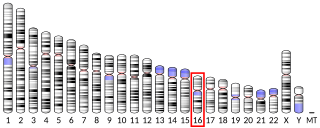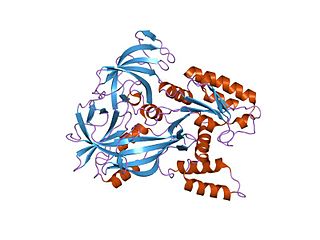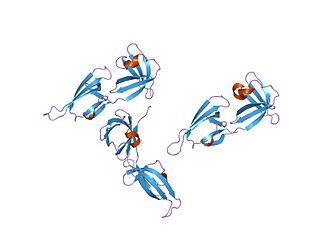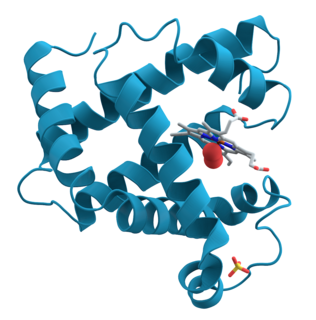
Elongation factors are a set of proteins that are used in protein synthesis in the process of cell cycle and elongation in some cells. In the ribosome, they facilitate translational elongation, from the formation of the first peptide bond to the formation of the last one. Bacteria and eukaryotes use elongation factors that are largely homologous to each other, but with a different nomenclature.

EF-Tu is a prokaryotic elongation factor responsible for catalyzing the binding of an aminoacyl-tRNA (aa-tRNA) to the ribosome. It is a G-protein, and facilitates the selection and binding of an aa-tRNA to the A-site of the ribosome. As a reflection of its crucial role in translation, EF-Tu is one of the most abundant and highly conserved proteins in prokaryotes. It is found in eukaryotic mitochrondria as TUFM.
Eukaryotic initiation factors (eIFs) are proteins or protein complexes involved in the initiation phase of eukaryotic translation. These proteins help stabilize the formation of ribosomal preinitiation complexes around the start codon and are an important input for post-transcription gene regulation. Several initiation factors form a complex with the small 40S ribosomal subunit and Met-tRNAiMet called the 43S preinitiation complex. Additional factors of the eIF4F complex recruit the 43S PIC to the five-prime cap structure of the mRNA, from which the 43S particle scans 5'-->3' along the mRNA to reach an AUG start codon. Recognition of the start codon by the Met-tRNAiMet promotes gated phosphate and eIF1 release to form the 48S preinitiation complex, followed by large 60S ribosomal subunit recruitment to form the 80S ribosome. There exist many more eukaryotic initiation factors than prokaryotic initiation factors, reflecting the greater biological complexity of eukaryotic translation. There are at least twelve eukaryotic initiation factors, composed of many more polypeptides, and these are described below.
eEF-1 is a eukaryotic elongation factor.

Eukaryotic translation initiation factor 5A-1 is a protein that in humans is encoded by the EIF5A gene.

Elongation factor 1-delta is a protein that in humans is encoded by the EEF1D gene.

Elongation factor 1-alpha 1 (eEF1a1) is a protein that in humans is encoded by the EEF1A1 gene.
In enzymology, an elongation factor 2 kinase is an enzyme that catalyzes the chemical reaction:

Elongation factor 1-beta is a protein that in humans is encoded by the EEF1B2 gene.

Eukaryotic elongation factor 2 is a protein that in humans is encoded by the EEF2 gene. It is the archaeal and eukaryotic counterpart of bacterial EF-G.

Eukaryotic translation initiation factor 2 subunit 2 (eIF2β) is a protein that in humans is encoded by the EIF2S2 gene.

Elongation factor 1-alpha 2 is a protein that in humans is encoded by the EEF1A2 gene.

Eukaryotic elongation factor-2 kinase, also known as calmodulin-dependent protein kinase III (CAMKIII) and calcium/calmodulin-dependent eukaryotic elongation factor 2 kinase, is an enzyme that in humans is encoded by the EEF2K gene.

EF-G is a prokaryotic elongation factor involved in protein translation. As a GTPase, EF-G catalyzes the movement (translocation) of transfer RNA (tRNA) and messenger RNA (mRNA) through the ribosome.

In molecular biology, the EF1 guanine nucleotide exchange domain is a protein domain found in the beta and delta chains of elongation factors from eukaryotes and archaea.

EF-P is a prokaryotic protein translation factor required for efficient peptide bond synthesis on 70S ribosomes from fMet-tRNAfMet. It probably functions indirectly by altering the affinity of the ribosome for aminoacyl-tRNA, thus increasing their reactivity as acceptors for peptidyl transferase.
Rck-2 is a gene that plays a major role in clock control of translation. Rck-2 protein is a kinase and is rhythmically activated through phosphorylation events based on the periodicity of the clock. Rck-2 activation is directly associated with the phosphorylation of eEF-2, which is an elongation factor that plays a major role in translation. Phosphorylation of eEF-2 has an inhibitory effect on the activity of translation. Rck-2 is largely studied in Neurospora crassa but has significant homology to humans. Knockout strains have been produced in the model organism N. crassa but there are no human pathologies associated with its deletion. While the basic mechanisms of circadian transcriptional control are known, little is understood about how the clock controls mRNA translation, which makes the characterization of pathways responsible for translational control all the more important.
Eukaryotic translation elongation factor 1 alpha 1 pseudogene 43 (eEF1A3) is a protein that in humans is encoded by the EEF1A1P43 gene.
Eukaryotic translation elongation factor 1 beta 2 pseudogene 1 (eEF1B1) is a protein that in humans is encoded by the EEF1B2P1 gene.
Eukaryotic translation elongation factor 1 beta 2 pseudogene 3 (eEF1B4) is a protein that in humans is encoded by the EEF1B2P3 gene.












